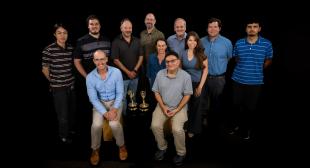Cal Poly Float Wins Extraordinaire Award at 2023 Rose Parade
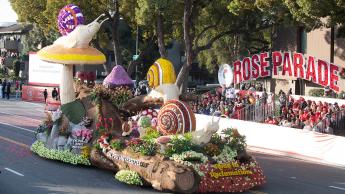
Photos by Tom Zasadzinski, Cal Poly Pomona
Cal Poly universities’ “Road to Reclamation” float that takes a small scene on a forest floor, featuring animated snails and colorful mushrooms, and blows it up to gigantic proportions received the Extraordinaire Award at the 134th Rose Parade® held Monday, Jan. 2.
The honor, announced two hours before the start of the parade, recognizes the parade’s most extraordinary float, including those 55 feet in length and greater, said Annie Doody, the Cal Poly San Luis Obispo team president. It’s the second time the schools have been lauded for creating the parade’s most extraordinary float; the first was 2019’s outer-space entry, “Far Out Frequencies.”
“I am so proud of everyone on this team and all the hard work they put into making this happen,” said Doody about 6:15 a.m.
The entry exemplifies the parade’s 2023 theme of “Turning the Corner” — celebrating the unlimited potential that each new year brings. “Road to Reclamation” transforms a small scene in nature and magnifies it to bigger-than-life proportions showcasing nature’s regenerative power.
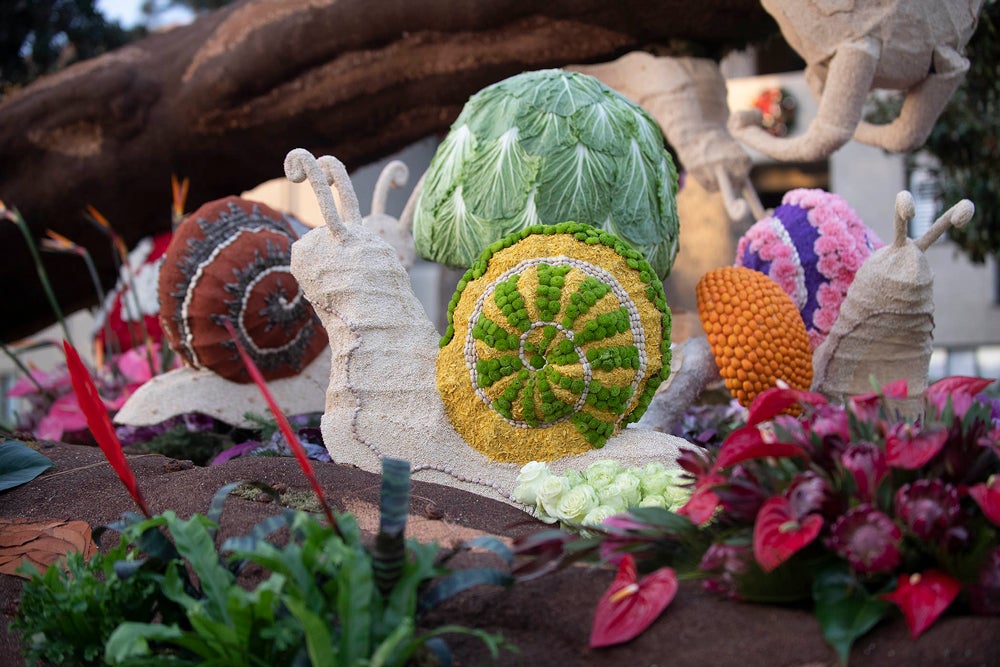
It stood out among other entries because of its cuddly assembly of colorful gastropods. Snails are very important to their ecosystems as they consume dead leaves on a forest floor and ultimately return it to the environment as soil. In addition, snails are a great food source for other creatures in the food chain.
Mechanical engineering student Benjamino Cruz, a four-year member of the Cal Poly team, submitted the original concept for “Road to Reclamation.” Cruz is the San Luis Obispo team’s construction chair, overseeing the yearlong process, who drove the float on the 5.5-mile parade route as one of the four unseen operators.
“I’m sleepy, but I’m ready to go,” Cruz said after hearing the announcement by parade officials at the Pasadena Tournament of Roses Association’s Tournament House.
Cruz, who spent a chilly night with the float at the parade staging area, agreed "Road to Reclamation" is an extraordinary work, adding: “I think just the composition of it. It looks like a painting from every angle. I’m incredibly proud.”
Earning another award is more than icing on a cake, it’s a form of validation for a year of hard work by scores of full-time students who also moonlight as part-time float builders on the two campuses, he added.
“That’s big — that’s big,” he said of the honor. “It just gives us a solid idea that we really achieved something.”

Riding shotgun with Cruz was the Pomona campus’s construction chair, Logan Hauptman, who is also studying mechanical engineering. The others who rode below the float’s decorative foam shell were: Jeremiah Lee, a third-year computer science student from Salinas, California; and Collin Marfia, a second-year history major, from Brentwood, California, both from Cal Poly in San Luis Obispo.
As drive-engine operator, Marfia oversaw the engine that propelled the float along the parade route “to make sure it doesn’t overheat or anything of that nature,” said Doody, who was the animation operator on the 2022 float. Teammate Lee operated the float animation.
The animations brought to life the three largest snails. Along with moving eyestalks, the front and back snails had articulated necks. The front snail was devouring a leaf, while the back snail put on a show of its own. It rode a flat-topped toadstool to a height of 25 feet; from its vantage point the snail’s head moved to gaze at paradegoers as the float rolled along. A trio of small “baby” snails, moved in a circle on the branch as if chasing each other. Finally, three ladybugs scattered across the diorama unfurled wings in preparation for flight.
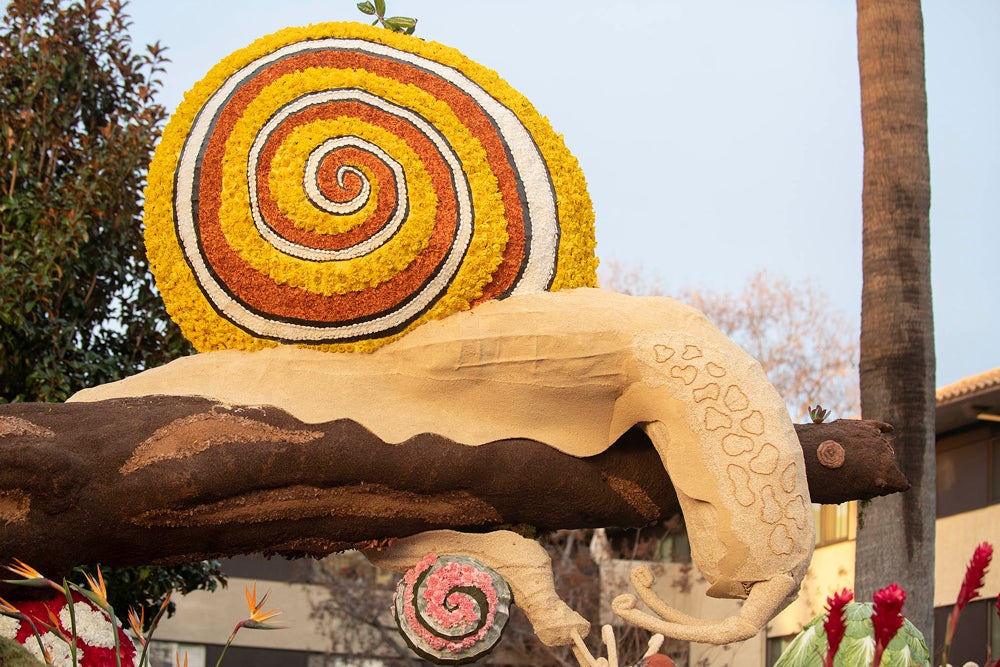
“This year one of the things our electronics team has been working on is actually redesigning an animation system,” Doody said. “They’ve written some script, and they’ve been figuring out how to connect hydraulic cylinders and motors to it so they actually will be using this new animation system for the parade. We’re all very excited about it.”
More than 70 students, equally split from each university, worked to finish the float, aided throughout the year by hundreds of student volunteers who turned out to assist on campus float workdays.
“Our student float builders combine the best of NASA innovation and ingenuity with the gee-whiz enthusiasm of a Broadway show; I couldn’t be prouder of them and their justly acclaimed reputation as dreamers, designers and float builders,” said Cal Poly President Jeffrey D. Armstrong, who was in Pasadena to watch the parade. “‘Road to Reclamation’ not only represents our students and their teammates from Pomona — it represents our Learn by Doing education to the world in a gorgeous holiday bouquet.
“Every Cal Poly float through the years has started as a simple spark of an idea that must be brought to life using skills learned in classrooms and labs, from computers and engineering to growing flowers. Students then put that knowledge into action with true grit — grinding, pounding and welding steel and machining parts, testing and retesting the mechanics, and finally burnishing the yearlong effort with the softness of an artist’s palette of floral color.”
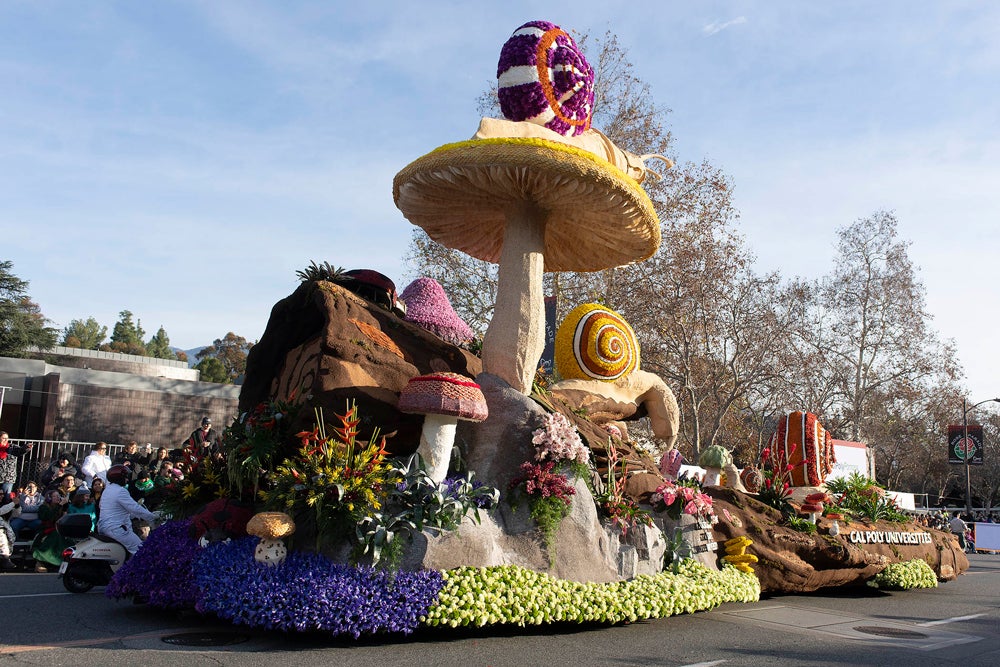
It was one of only six self-built entries in this year’s extravaganza. The parade included 38 other floats, including one for the Royal Court and each of the Rose Bowl teams, Penn State and the University of Utah, as well as 21 marching bands, 16 equestrian units and the 2023 grand marshal, former Arizona U.S. Rep. Gabby Giffords, whose recovery from a January 2011 assassination attempt epitomizes the parade’s 2023 “Turning the Corner” theme, organizers said.
Rose Parade® officials estimate that 700,000 people saw the event in person, while last year 28.5 million Americans and a worldwide audience estimated at 28 million watched it on TV. In 2022, viewers in 70 nations tuned in to the coverage.
Awards were announced by 2023 Tournament of Roses President Amy Wainscott about 6 a.m., two hours before the start of the parade that traveled north on Orange Grove Boulevard and then east onto Colorado Boulevard.
The students’ creativity extended to the decorations. Shifts of students and decoration volunteers in the week before covered the entire visible surface of the 18- by 55-foot float with an estimated 20,000 flowers and natural materials.
The branch rested on a forest floor of mixed greens including student-grown clover mats, interspersed with mixed verdant floral and foliage — green roses, green trick, kale and ferns. Reflecting the float theme of renewal and giving old materials new life, the branch bark was real: donated and foraged ponderosa pine and redwood bark. Between bark slabs of was dried moss or floral material that represent mosses and lichens. Chrysanthemums, kale and Gerbera daisies, among other materials, helped create the effect.
Snails were festooned with a variety of materials — chrysanthemums, carnations, nuts and roses. Deep-purple carnations were used on the tallest snail. This “moonshade” variety is not a color commonly found in floral material.
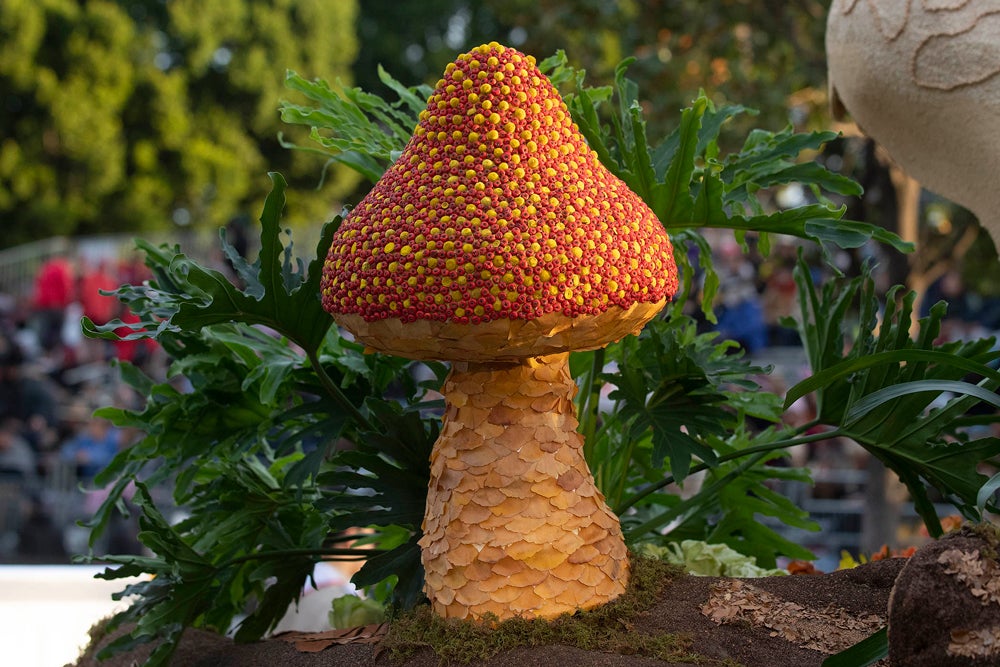
Mushrooms were topped with such materials as mums, carnations, roses, flower petals, fresh produce, seeds and beans. To achieve interesting textural elements on the mushrooms, students used slices of eggplant, orange slices, cabbage leaves and other produce, along with dried, sewn-together corn husks for the ruffled mushroom gills. And the ladybug shells were covered with cranberry halves that provided a dimpled surface of one of the entry’s animated features.
The schools enjoy a rich history in the Tournament of Roses® Rose Parade. Among this year’s participants, the Cal Poly universities’ 74th appearance ranks fifth highest behind South Pasadena — the most venerable with 128 — followed by Southern California cities of Alhambra (94), Sierra Madre (91) and Burbank and (90).
Cal Poly Rose Float team takes pride in its Pasadena connection. In the fall of 1948, students from San Luis Obispo and Pomona first came together, across 220 miles, to produce a float for the 1949 parade. Since then, the two schools’ entries have earned 62 total awards over the years. Next year’s float will mark their 75th entry in the storied event.
In addition to the Rose Parade® trophies, the program has earned countless accolades for its innovations such as include computer-controlled animation, hydraulic systems and cleaner emissions with propane later incorporated by professional float builders.
Cal Poly’s Learn by Doing ethos is exemplified in all facets of the float program, as students from throughout all six of the university’s colleges get hands-on experience welding, metal shaping, machining, foam carving, woodworking, painting and flower harvesting — ultimately competing against professional float builders with corporate sponsorships, said Jesus Velasquez, 21, a third-year aerospace engineering major who is the materials testing lead on the San Luis Obispo team.
“Overall, you learn to be a leader capable of making decisions and learn skills that are different from your major,” said the Hawthorne, California, resident. “Engineers might learn about flowers and arrangements; business majors may learn to weld; and English majors may program an Arduino (software). Everyone gains.”
Want more Learn by Doing stories in your life? Sign up for our monthly newsletter, the Cal Poly News Recap!




